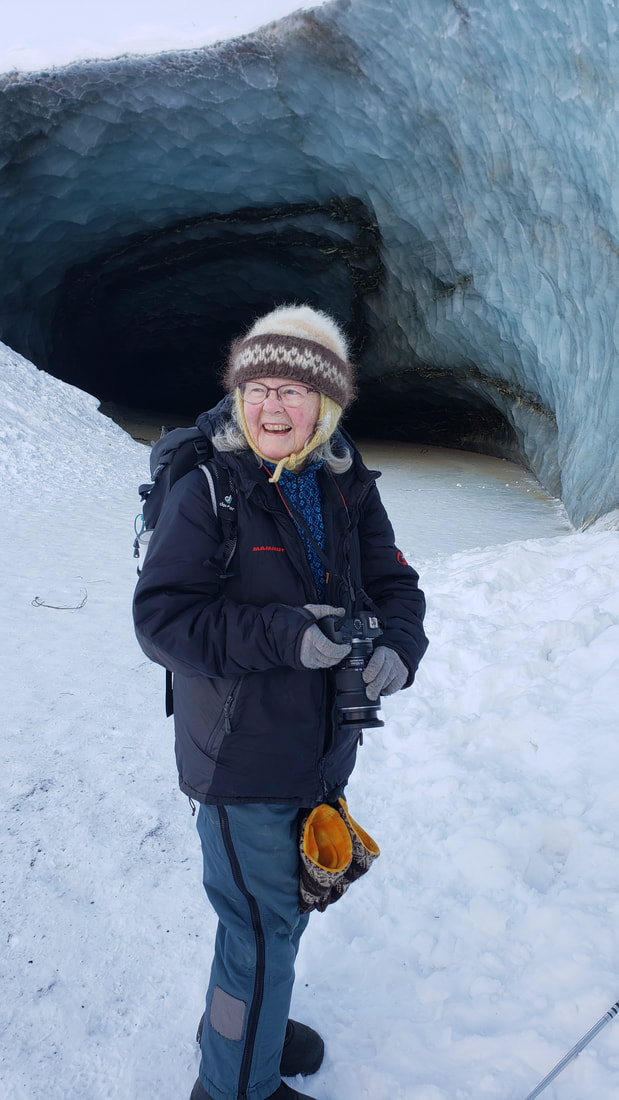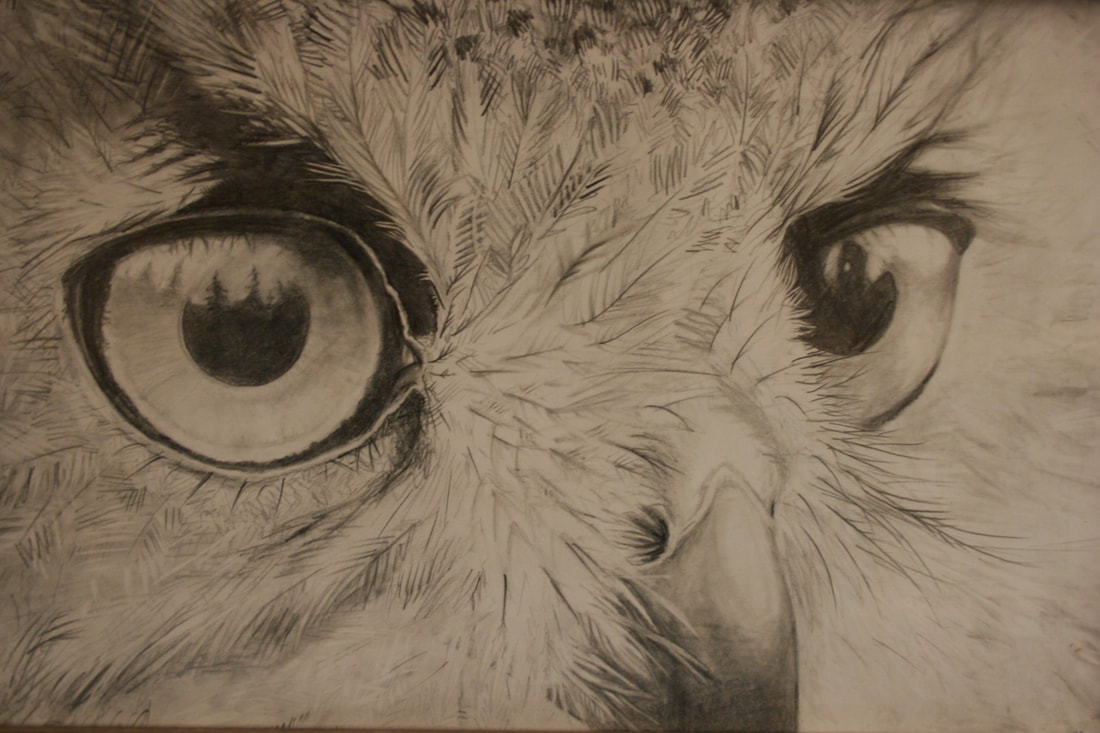|
By Robin Mayo As we jumped out of our warm cars and quickly got dressed for a day hike in the Alaska Range in December, my friend observed that she’s always trying for the perfect outfit. We agreed that it is an elusive quest, and there is rarely a perfect solution. At the parking area, sluggish from the drive and facing a brisk wind, we bundled up. But just a few minutes down the trail, which was blown in and involved occasional “post-holing” we were stopping to take off layers and stuff them in our packs. At our destination, where we stopped to take pictures and have a snack, the layers went back on. I was a little chilly when we started walking back, but again warmed quickly as soon as we got moving. To make the problem even more challenging, everyone’s body reacts to cold a little differently. Some people suffer from cold toes, while others fiercely dislike wearing hoods or large hats. Dressing for the cold is not a single formula but a complicated personal creative process. But please don’t give up! Especially with all the wondrous modern insulations and fabrics, it is worth figuring it out so you can get outside and enjoy the winter beauty. The Basics: For any sustained time outdoors in winter, you will need to add insulation to your whole body. The biggest parka in the world will not help you if your legs are clad only in jeans, or enable you to go without decent boots, mittens and headwear. The basics include “base layers” for the whole body, especially warm socks and long underwear. You should also have insulated and windproof layers for your whole body, including pants, coats, hats, mittens, and boots. Insulation = Air: Truth is, it isn’t the garment itself which keeps you warm, but the air it traps. Look for items which are puffy and loose enough to trap some air. If an insulated garment is too tight, the insulation won’t be able to do its job. My current winter jacket is a men’s large, which makes me wonder what large men wear, but it has room for several layers underneath, and the sleeves are long enough to pull over my hands. When in doubt, choose the larger size, keeping in mind that if a garment is way too big it will be drafty and not as warm. A mushing friend uses the memorable rule of thumb that “your snowpants should be so puffy that you need a back-up beeper for your butt.” Layers are the secret ingredient: Even if your jacket and snowpants are excellent, it is important to wear several layers underneath. This traps more air, eliminates drafts, and gives you options. On a drizzly blueberry picking foray in Thompson Pass last fall, I suddenly realized my young puppy was dangerously cold. I took off one of the layers I was wearing under my raincoat to wrap her up, and soon after made her a raincoat of her own. Ideally your “next to skin” layer should not be cotton. It traps moisture and can make you cold. Instead look for synthetics, silk, or wool. Technical base layers can be expensive, but many pajamas and loungewear are made of synthetic materials. Last time I was at New to You there was an amazing array of fuzzy pajama pants and lightweight fleece jackets and pullovers which would work perfectly. Windbreakers are magic: For WISE programs, we have a bag of raincoats and rainpants, which are often deployed in chilly situations even if there is no rain. Especially if clothing is at all damp, the slightest breeze sucks the warmth out of you. As well as windproof layers for your body and legs, think about windproof mittens and make sure your jacket hood is big enough to fit over your hat. Accessorize for the perfect combo: Collect a variety of hats, mittens, socks, and neckwear so you can try different combinations and learn what works for you. I like to wear a lightweight stretchy neck tube (Buff is a popular brand) under a thicker fleece neck gaitor. These layers can be pulled up or down in various combinations to protect my chin, cheeks and nose. For strong winds or riding the snowgo, I add a lightweight windproof balaclava. I top it off with one of my many fuzzy hats, and pull up my hood if needed. That old adage about losing 30% of your body heat through your head is true, plus ears, noses and cheeks are easy prey to frostbite. For my hands I also use a layering strategy. A pair of thin gloves enable me to operate zippers and snaps, and can slip inside a larger pair of mittens. I wear my overmitts dog-musher style, on a cord around my neck so they can be easily slipped off but won’t be left behind. Ignite your Inner Furnace: Your body generates heat from movement, but when we start to feel cold we often “shut down,” and stop moving. A brisk walk, jogging in place, some jumping jacks, or a silly dance are often all you need to crank up the furnace. I’m going to take a potentially unpopular stance here and discourage use of those neat little “hot packs” as a substitute for dressing right and moving your body. Don’t get me wrong, they have some great uses, especially in emergencies and for people with compromised circulation. But especially for kids, using them as a substitute for learning to dress warmly and use the power of our own bodies is a disservice in the long run. It is also important to feed your furnace with high-energy foods, including quick-burning fats and carbs. This is another self-care skill we can teach kids, paying attention to fueling their bodies. Eating may make you colder at first as your body kicks into digestion mode, but especially in the long run it is super important. Know the signs of trouble: Cold injuries and conditions are serious and escalate quickly. Frostbite and hypothermia are the most common, and can be hard to diagnose in ourselves, but easily spotted by companions. A patch of white skin on the nose, cheeks, or ears is often the first sign of frostbite, and should be covered and gently warmed immediately. The first sign of hypothermia is “the -umbles.” The victim may mumble when they talk, stumble when they walk, and fumble when they try to use their hands. Unfortunately, hypothermia also often includes apathy and even flat-out denial, so you may need to be assertive to help your friend add layers and get moving to warm themselves. More advanced hypothermia and frostbite are serious medical emergencies which require skilled response. Photo Caption: My Mom celebrates her 83rd birthday with a January hike in the Alaska Range. It was about -10F with a cold breeze. She is wearing light gloves to operate the camera, and keeping heavy overmitts ready.
0 Comments
Copper River Record October 2014
By Janelle Eklund It was October 4 along the Kenai River near Cooper Landing. A bright crisp autumn winterish kind of day. Birch, Aspen, and cottonwood golden leaves still hung like ornaments on the trees. As we approached the summit of the narrow trail large fluffy white flakes of snow drifted down from a grey sky. They accented the last days of autumn colors and nearly morphed into water after touching down. Our hearts leaped at the beauty that surrounded us. Others, bundled up against the cool air, were out to enjoy the last vestiges of fall and welcome in the debut of winter. A different kind of snow swirled around the car as we drove out of the Copper Basin on October 3. The flakes were smaller and dryer. And unlike Cooper Landing, when we got home 6 days later, about eight inches of the millions of flakes had accumulated and stayed on the ground. Snowflakes are actually snow crystals and they are not made from raindrops. They actually are born from water vapor in clouds which changes into solid ice. Once the process begins and water vapor keeps clinging to the developing crystal and freezes, it forms beautiful patterns and shapes. Some of these snow crystals bump into each other as they are falling, creating more elaborate patterns. I think this is what was happening with the large flakes we saw at Cooper Landing. Although I wasn't able to capture one and look at it closely in a microscope. It intrigues me that, out of all the millions of snowflakes that fall at any given time, no two are alike. They are as different as we are. And each one has its own theme. It could be a plate or a column. It could be branched, sectored or hollowed. And it could have six sides or twelve sides. Nature does not make eight, four, five or seven sided snow crystals. Mostly you will see six sided ones with some side branches. Sometimes the side branching is symmetrical but mostly not. Some crystals could appear to have their structure decorated with beads. These are water droplets falling through the cloud and as it came in contact with the crystal it froze, creating little tiny beads throughout the crystal. For all that goes into the intricacies in the birth of a snowflake, it's original shape is very short lived. Once it hits the ground it may melt if the ground has not frozen yet, as in September/October. But if the ground is frozen and it's cold enough, the crystals lay on top of each other where they bind and change form. It's now not just one flake but many flakes working together. Like a weaving, it makes a beautiful white blanket across the land to protect it and its inhabitants from the sub zero temperatures of winters breath. Weather influences what kind of form it takes too. The wind can play a part in the metamorphosis of the snowflake. Wind will pulverize it and get it moving like the mother hen scooting her brood along, packing it into hard snow drifts. Temperature also plays a role in the metamorphous of the snowflake. Snowflakes working together create a snowpack that is very insulating. The snow at the bottom of the layer can be 30° to 40° warmer than the top of the snow. Many people, including myself, have taken advantage of the snow pack to give the base of my house an extra layer of insulation. There are whole books written on snow (see references). The mysteries of snow crystal formation still intrigue those that seek to learn its secrets. "No weary journeys need be taken, no expensive machinery employed.... A winter's storm, an open window, a bit of fur or velvet, and a common magnifier, will bring any curious inquirer upon his field of observation with all the necessary apparatus, and he has only to open his eyes to find the grand and beautiful laboratory of nature open to his inspection." -Frances Chickering, Cloud Crystals: A Snow-Flake Album, 1864. From my light to yours- References: The Snowflake, Winter's Secret Beauty, by Kenneth Libbrecht; Apun The Arctic Snow by Matthew Sturm. By Janelle Eklund
Copper River Native Association, Wrangell St. Elias National Park & Preserve (WRST), and Wrangell Institute for Science and Environment (WISE) teamed up to teach CRNA teens some winter survival skills on February 22. The teens enjoyed getting out on the ice at Pippin Lake to ice fish, make snow shelters and learn about caribou tracks. Volunteer, Charles Nuipok taught the teens how to make fishing poles with diamond willow sticks, line and a hook. Armed with their new fishing poles they ventured out on the ice where holes were drilled. Scooping ice out of the holes revealed lots of tiny shrimp. WISE instructor, Paul Boos and WRST education specialist, Glenn Hart, explained how fish feed on these shrimp. The teens were excited and promptly abandoned the commercial bait for shrimp bait. Two separate layers of ice on the lake prevented the fishing lines from getting to the bottom but the fun of the learning experience was worthwhile. Nuipok and WISE instructor, Janelle Eklund supervised the teens digging out a snow shelter on a couple of snow mounds that someone had conveniently placed nearby. Time ran out before the shelters were finished but the teens learned what it takes to build a shelter that will protect you from the weather. Glenn Hart demonstrated what caribou tracks look like and explained the features of the hooves. The teens got to make “their own” caribou tracks and next time will be able to make casts of tracks in the snow. Many of the teens had not been to Pippin Lake before and they enjoyed the day learning about winter skills. |
Who We AreWISEfriends are several writers connected with Wrangell Institute for Science and Environment, a nonprofit organization located in Alaska's Copper River Valley. Most of these articles originally appeared in our local newspaper, the Copper River Record. Archives
August 2021
Categories
All
|
|
WISE is a
501(c)3 nonprofit organization |
Contact Us |



 RSS Feed
RSS Feed
